Biomaterials
Hydrogels as artificial organs
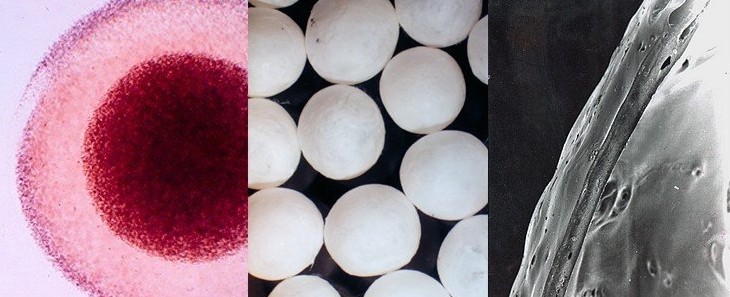
A view of incubators in form of capsules for cell proliferation
"Hybrid organ"
"Hybrid organ"
Three-dimensional networks of crosslinked polymers embed water molecules and therefore are attractive for many application-oriented studies.
A hybrid organ is understood as a matrix with viable cells shielded by synthetic or natural semi-permeable polymer layers from the recipient immunological system. The layers should enable exchanging nutritive and secretory compounds. The inner structure is designed to support cellular metabolism and cell proliferation. This is also essential that biocompatibility is ensured if such the device is to be implanted.
Schematically, hybrid artificial organ is given below:
A hybrid organ is understood as a matrix with viable cells shielded by synthetic or natural semi-permeable polymer layers from the recipient immunological system. The layers should enable exchanging nutritive and secretory compounds. The inner structure is designed to support cellular metabolism and cell proliferation. This is also essential that biocompatibility is ensured if such the device is to be implanted.
Schematically, hybrid artificial organ is given below:
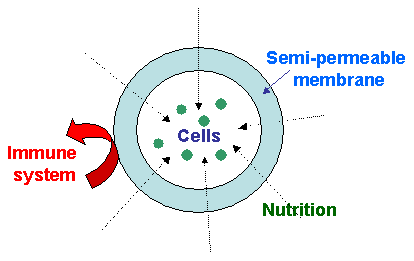
Implanting and grafting of organs is known as surgical methods that can save patient life. It is generally accepted and applied in many countries however several problems like organ shortage for transplantation or rejection of allogenic or xenogenic grafts are often mentioned in literature. These are driving forces of many laboratories to work out a very good alternative candidate for support of malfunctioning organs.
A great number of the cell encapsulation techniques have been developed during recent years. A few years ago experiments on construction of so-called artificial hybrid organs were initiated at the IARC and afterwards polymeric scaffolds for cells were proposed. Our approach to the problem of artificial endocrine organ preparation was to construct a polymeric matrix for cells (pancreas, thyroid...) that would serve as a support for cell proliferation and protection against human immune system specific components.
In consequence, the methods of gentle encapsulation of cells and additional protection via supplementary covering with natural and synthetic polymers were established. The methods of micro- and macro-encapsulation were tested with blood corpuscles, thyroid and pancreas cells as well as Saccharomyces Cerevisiae (yeast cells) and rat fibroblasts. The scaffolds provide adequate conditions for cell multiplications and protect them from immunoglobulins, however semi-permeable membranes allow small compounds to diffuse into a capsule.
Typical designed capsules are shown below:
A great number of the cell encapsulation techniques have been developed during recent years. A few years ago experiments on construction of so-called artificial hybrid organs were initiated at the IARC and afterwards polymeric scaffolds for cells were proposed. Our approach to the problem of artificial endocrine organ preparation was to construct a polymeric matrix for cells (pancreas, thyroid...) that would serve as a support for cell proliferation and protection against human immune system specific components.
In consequence, the methods of gentle encapsulation of cells and additional protection via supplementary covering with natural and synthetic polymers were established. The methods of micro- and macro-encapsulation were tested with blood corpuscles, thyroid and pancreas cells as well as Saccharomyces Cerevisiae (yeast cells) and rat fibroblasts. The scaffolds provide adequate conditions for cell multiplications and protect them from immunoglobulins, however semi-permeable membranes allow small compounds to diffuse into a capsule.
Typical designed capsules are shown below:
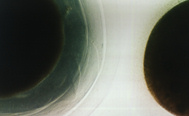 |
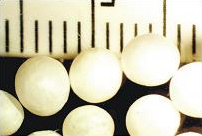 |
|
| Cross-section of natural polymer capsules with immobilized blood and covered with natural polymer membranes - microscopic view | Capsules made of natural polymer additionally covered with synthetic polymer - a view under magnifying glass |
Antibacterial Hydrogels
If aqueous monomer/polymer solution is turned into aqueous crosslinked system one can call it a hydrogel. Some natural or synthetic polymers may serve for construction of 3D networks with specific biologically-active molecules entrapped inside. If active moieties are permanently bonded to polymer chains, hydrogels systems will not release them. Otherwise, release of those substances is likely in prolonged or short time or in controlled manner, and is triggered by alteration of pH, temperature, ionic strength, electrical current or mechanical stress. Stimuli-sensitive hydrogels may swells as well that is of significant importance in some applications. These features have been taken into account in constructing of antibacterial gels - see below the photos.

If biological application is taken into consideration bactericidal action and swelling can be important (annihilating bacteria action on a wound, soaking wound fluids). Some constructed gels revealed high potential of absorbing aqueous solutions, as can be seen below:
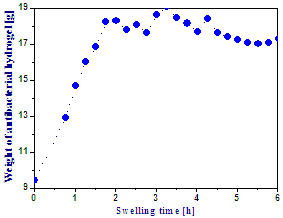
It is also possible to obtain thin layer of hydrogel bactericidal compositions on textile support, which will strengthen especially those gels of low mechanical properties. Agar tests revealed appropriate antibacterial features of such textile material:
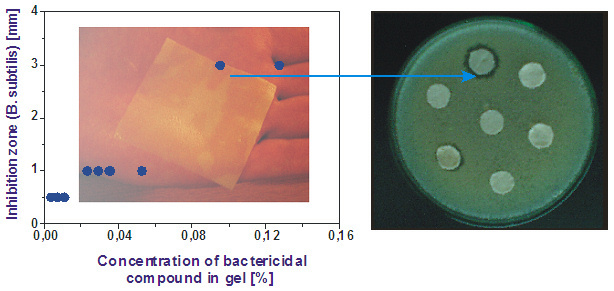
Among advantages, transparency, adhesion to body shapes, enhanced mechanical strength as well soaking and bactericidal properties of the textile-hydrogel composites can be mentioned.

